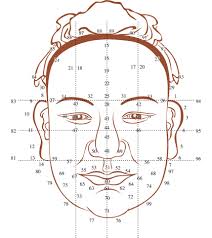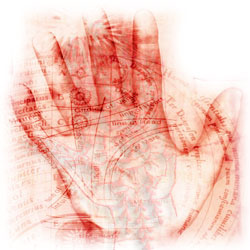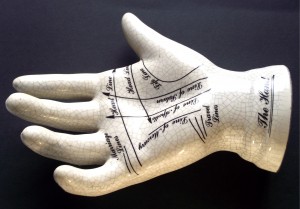Face and Palm Reading
What is Face Reading?
 Face reading is the Chinese art of predicting a person’s fortunes by analyzing the different elements of his or her face. It takes into account the shape of the following features of your face: ears, forehead, eyebrows, eyes, cheek, nose, mouth and chin. It can help to predict your future and guide you along the road of success.
Face reading is the Chinese art of predicting a person’s fortunes by analyzing the different elements of his or her face. It takes into account the shape of the following features of your face: ears, forehead, eyebrows, eyes, cheek, nose, mouth and chin. It can help to predict your future and guide you along the road of success.
The Chinese technique of face reading starts with the ears: the left ear tells your fate from birth until the age of seven, while the right ear corresponds to the ages of age 8 to 14. Next, the face is divided into 3 sections. The upper section includes the forehead, which determines your fate from age 15 to 30 and is called the celestial region. The middle section, called the human region, runs from the eyebrows to the nose and dictates your destiny from 31 to 50. During this period, your success or your fortunes will rely mostly on your own efforts. Finally, the lower section, called the earthy region, includes the bottom of the nose to the chin and concerns your fate after the age of 50. This is a period in which your achievements on the earth are already well-established.
If the three regions are equally proportioned you will have a balanced life throughout your existence without any drastic changes, good or bad. If any of the three sections is larger or smaller than the other two, it means your fate will be better or worse during the corresponding time.
The lines of your palm are like a roadmap to your thoughts, emotions and your physical vitality in life. But they also indicate the life experiences you been through, and what could be in store for the future. Palm reading, also known as Chiromancy, is a fundamental technique in Chinese fortunetelling and has been practiced for thousands of years.
According to Master Hanz Cua, expert in Palm Reading and Feng Shui, reading someone’s hand was a common technique of fortunetelling because it was quick and reliable. “You don’t need to know someone’s birthday or their personal history. You simply look at the person’s hands and you can a read a lot of information about them from the lines alone. Every person’s hand is unique because it showcases your personality, your state of health, as well as the past and your possible future.”
In palmistry, it is traditionally believed that for a woman, the right hand reveals what you are born with; the left shows what you have been through and what you have achieved. For men it is reversed, therefore the left hand of a male is the experiences he has gathered, the right shows what he was born with. Read more..
What is Palmistry?
Palmistry: Revealing The Future And The Past in Your Hands
 The hand is a critical component of the human body. We have more than 200 million nerve fibers in our brains, and a significant number of these are exclusively connected with the hand. Today, the study of the lines and patterns on the hand has many applications in addition to the art of palmistry. Based on the work of seventeenth-century physicians like Nehemiah Grew and Jan Purkinjie, both of whom lectured and wrote extensively about the uniqueness of fingerprints, modern physicians have been able to develop interesting parallels between hand types and physical challenges or illnesses like Down’s Syndrome or even cancer.
The hand is a critical component of the human body. We have more than 200 million nerve fibers in our brains, and a significant number of these are exclusively connected with the hand. Today, the study of the lines and patterns on the hand has many applications in addition to the art of palmistry. Based on the work of seventeenth-century physicians like Nehemiah Grew and Jan Purkinjie, both of whom lectured and wrote extensively about the uniqueness of fingerprints, modern physicians have been able to develop interesting parallels between hand types and physical challenges or illnesses like Down’s Syndrome or even cancer.
Many psychologists recognize the correlation between specific lines and patterns on the fingers and hands and well-defined personality characteristics. Carl Jung, one of the founders of psychoanalysis, believed that palmistry is the outward appearance of secrets we try to keep under lock and key in our subconscious minds. Another noted psychologist, Charlotte Wolff, believed that “the hand is a visible part of the brain”; she even diagnosed many of her patients using hand-reading techniques.
Modern Palmistry
 Handanalysis is a matter of combination (combining hand features), and it is the intuition and experience gained from reading hundreds or even thousands of hands that allow a handreader to give an insightful reading. The hands are read as a ‘whole’, not by looking at each feature in isolation. It is not just the study of the palm (as suggested by ‘palmistry’), but of the entire hand. This includes the shape of the fingers, the ridges on the nails, the skin ridges, the color of the skin…every feature is significant to a handanalyst. With enough experience, a handanalyst reads a hand the way we read each others faces in everyday life. We don’t look at the way the lips curl to understand that someone is smiling. We look at the face as a whole. But if you have to describe the features of a face that make a person look old or excited or in love or whatever, you’re in trouble.
Handanalysis is a matter of combination (combining hand features), and it is the intuition and experience gained from reading hundreds or even thousands of hands that allow a handreader to give an insightful reading. The hands are read as a ‘whole’, not by looking at each feature in isolation. It is not just the study of the palm (as suggested by ‘palmistry’), but of the entire hand. This includes the shape of the fingers, the ridges on the nails, the skin ridges, the color of the skin…every feature is significant to a handanalyst. With enough experience, a handanalyst reads a hand the way we read each others faces in everyday life. We don’t look at the way the lips curl to understand that someone is smiling. We look at the face as a whole. But if you have to describe the features of a face that make a person look old or excited or in love or whatever, you’re in trouble.
Those that have written books on the subject did exactly that: they attempted to pinpoint specific features, or a combination of features, that indicate a character trait. Last century a handreader might have told you how many children you’ll have and whether or not your marriage will last. Today, a handreader or handanalyst is more likely to tell you about your strengths and weaknesses, so you can use this knowledge to better shape your future. Fortunetellers still exist that use the hand as a guide, but in modern handreading this practice is becoming increasingly rare.
The lines on our palm change throughout our entire life – prints of the same pair of hands over time are evidence of this phenomenon. If you think your hands look exactly the same now as they did a few years ago, you probably haven’t paid much attention to them. Small changes in lines do occur and lines can appear and disappear, in particular when it comes to what are seen as stress or nervous lines: those within the life line/around the thumb (‘Venus’ mount), or the ‘mercury’ line on the ulnar/percussion side of the hand, going from the life line to the little finger. Handanalysts say that big changes in our lifestyle correspond with big changes on our hands, too. Especially on the major lines: the Life Line, the Head Line and the Heart Line. The Fate Line is also usually considered to be one of the major lines. They are easily identified as the strongest lines on your palm, although the Fate Line is often less clear and sometimes almost non-existent. Some variations can occur: the Life Line and Head Line may exist as one line, called a Simian Line and some people actually have the opposite manifestation: a double Head and/or Heart Line. The names given are a bit deceiving, though. Traditional palmists did actually read your fate from your Fate Line and your life-span from you Life Line. But the meanings have changed somewhat to ‘the way you set your goals’ and ‘your social identity’ respectively. Reading hands is a matter of combining handfeatures, as it is difficult to say something just about just one single feature of the hand without looking at it in the context of the rest of the hand (although this is still done quite often). A long ring finger is said to be indicative of creativity, but – you may ask – how come there are plenty of creative people with a short ring finger? The handreader would say: one has to look at the rest of the hand, too, because handreading is a matter of combination. This is what makes handreading very complex. A lot of intuition is involved, and it is difficult to write down these intuitions of years of handreading experience accurately to share with others. But don’t let this discourage you; there is a lot to discover in the palms of our hands, and the good news is: they’re still discovering.